The port's builders have already allegedly constructed a "kutcha" road through the village and a nesting ground for Olive Ridley turtles.
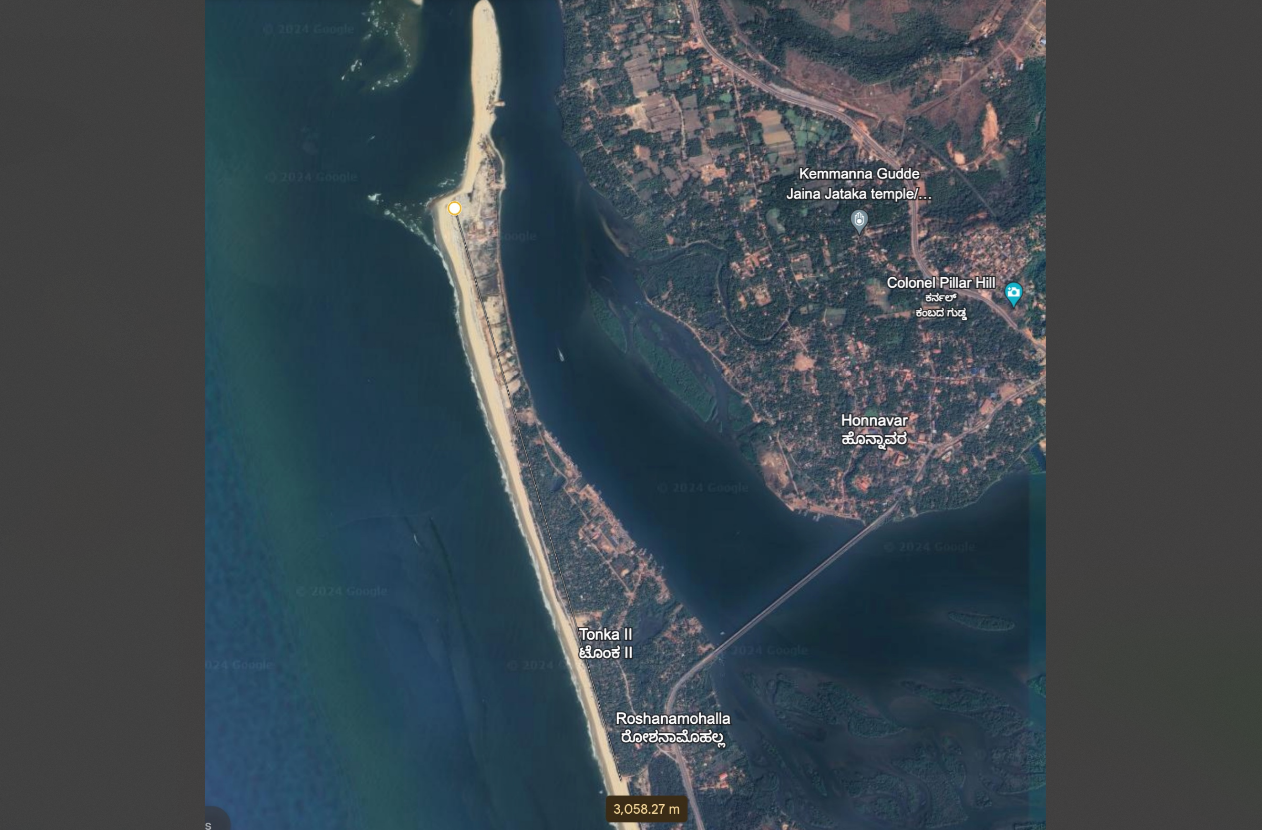
Ariel view of Honnavar
The sea was always their playground, where they ventured without fear, though the waves would often try to spook them.
The water never intimidated the fishermen of the Tonka hamlet in the Honnavar taluk of Karnataka’s Uttara Kannada district.
The men in boats carried on with their business as the master steered the boat clear, and out into the open sea, where sometimes a bounty awaited them in the waters of the Arabian Sea.
Times have changed. A fear has now gripped them each time they sail out. They cast glances at the shrinking shore as the boat sails out into the horizon.
They are not sure if the houses they have just left will remain intact when they return — or if they will come back to the bulldozed ruins of the building they once called home, with their dear ones thrown out.
Authorities have decided to construct a four-lane road to replace the existing dirt road between Kasarkoda (not to be confused with Kasaragod in Kerala) and Tonka, to an upcoming private port close to the National Highway. The move may affect 6,000 people in this hamlet.
The fishermen said the port authorities have received all the necessary clearances: From the Department of Environment and Forests and the district administration.
On Wednesday, 31 January, a team of surveyors from the district administration, accompanied by a posse of police personnel, descended on the fishers’ village.
Even as an entire startled community — men, women, and children — looked on, they started surveying and marking the area, without offering any explanation.
The fishermen objected to the survey. A clash broke out between them and the police. The police bundled 18 fishermen, including their leader Rajesh Tandel, into a vehicle and sped towards the Honnavar Police Station.
The news of the arrest spread fast in the neighbouring villages. Hundreds of people reached the police station in no time, demanding the release of the arrested 18.
The crowd kept swelling at the police station and in front of the taluk court where the arrested fishermen were to be produced.
The police, instead of presenting them at the jurisdictional court, took the 18 accused to a court in Kumta. The court sent them to judicial custody.
“These fishermen were booked under the non-bailable Section 353 for criminal assault and obstructing public servants from discharging duties among other sections of the IPC and were denied bail,” police sources told South First.
Their bail application would come before the court on Monday, 5 February.
Incidentally, it was not the first time that the fishermen’s community locked horns with the local authorities.
“It has been going on since 2017 when the fisherfolks learnt that a Hyderabad-based private port company — handling coal, iron ore, and general cargo — was coming up at Honnavar,” Sandeep Hegde, founder of the charitable trust Honnavar Foundation, told South First.
The NGO works closely with the fisher community.
“They are apprehensive that their traditional fishing routines will get affected or controlled. They are also nervous about how their communities will be affected, as there were rumours that the port company will construct a four-lane road that would go through their village,” he said.
Earlier, the Karnataka government constructed around 600 houses for the fishermen under the “Ashraya” scheme.
If the four-lane road materialises, several houses under the scheme would also be razed, said Hegde.
A large number of fisherwomen depend on the serene beach to put their fish to dry, their only livelihood. They dry the fish on the sunny beach with clean air.
They expressed fear that once the port materialises, the movement of heavy vehicles ferrying coal and iron ore on the aforementioned road would pollute the atmosphere and jeopardise their livelihood.
The fishermen community approached the local elected representatives, but to no avail. They then sought the help of a few NGOs led by marine biologists and environmentalists, including the Honnavar Foundation.
The NGOs are supporting the community, filing suits against the private port company for alleged violations of the National Green Tribunal (NGT) norms.
The final Environmental Impact Assessment (EIA) report of the project, from February 2012, states that there is a single-lane black-topped road that runs parallel to the shoreline, and the private port site could be approached by that.
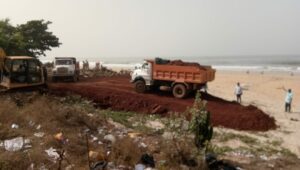
The Kutcha road being made by dumping debris in June 2021 on the nesting grounds of the Olive Ridley Turtles on the beach
However, the local fishermen claim that there is no such road anywhere nearby.
But something happened during the Covid-19 lockdown. In 2021, the port company’s men created a kutcha road by dumping debris on the shoreline, which falls under the Coastal Regulation Zone (CRZ), allege fishermen.
Hegde said there was no such road earlier. It was a beach and nesting grounds for the Olive Ridley turtles — a marine species protected under Schedule-I of the Indian Wildlife Protection Act of 1972.
“The road, which stretches around 3 km, not only runs through the fisherfolks’ villages and the beach but also through the nesting grounds of the Olive Ridley turtles that are legally protected under the Wildlife Protection Act,” Hegde pointed out.
“During the Covid-19 pandemic in June 2021, there was a dubious activity by a group of men belonging to the company who managed to dump truckloads of debris and mud along the shoreline,” he told South First.
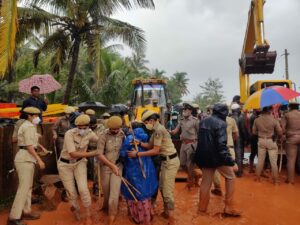
Police taking on protesting fishermen community women when the kutcha road was being made in 2021 during Covid pandemic
“They created a kutcha (dirt) road connecting a private port nearby through the fisherfolk’s village so that this ‘access road’ would further connect to the highway,” he said, adding “When there was not even a road in the first place, they had mentioned it as a blacktopped road in the EIA report of 2012 and created a kutcha road with police protection in 2021 — well within the CRZ, for their vested interest only to mislead everyone with this narrative.”
Hegde said the fishermen were the ones who were initially misled. “When asked about the construction, the workers informed them it was not a road but a structure for protecting the shoreline, but eventually it turned out to be a kutcha road. However, they continued protesting against the road makers, company officials and the police,” he said.
“Not just the road, the shoreline adjacent to the port is also a nesting area. This year, 300 eggs are already there in that area,” Hegde said.
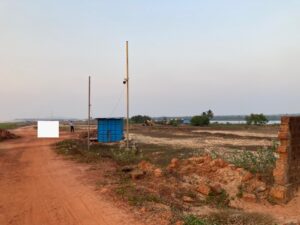
The land leased to the private port – Honnavar Port Private Limited
Marine biologists said Olive Ridley turtles lay somewhere between 100 to 110 eggs each.
These turtles reach sexual maturity at approximately 15 years of age, which is an early age compared to other sea turtles.
Documentary filmmaker Vikas Badiger’s The Ocean Connection depicts a fishing hamlet in Honnavar, the fishermen community and their religious belief Koorma Avatar linked to the conservation of Olive Ridley turtles.
The port’s final EIA report stated that the proposed facility, Honnavar Ports Private Limited (HPPL), would be located at the mouth of River Sharavathi, northwest of Kasarkoda Tonka village in Uttara Kannada district.
According to estimates, the port would handle 4.9 Million Metric Tonnes Per Annum (MTPA) of cargo.
The EIA also said that there were no breeding or spawning grounds for fish or other marine life at the port site.
“It is true,” Hegde said, “that the port site happens to be in a land which is not in dispute or any controversy.”
He explained: “However, the access road that they (the private port’s makers) illegally demarcated runs right through the nesting grounds of the Olive Ridley turtles. There is also a board saying it is a nesting ground.”
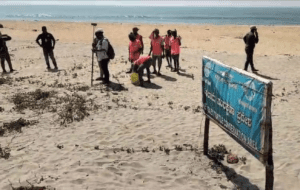
Surveyors carry out their work at the Olive Ridley turtle nesting ground area where a board also have been put up.
The Environmental Clearance and the EIA report stated that no wildlife would be affected.
Environmentalists said it would adversely affect Olive Ridley turtles that should be conserved.
The final EIA report said the port was not located in environmentally sensitive areas such as national parks, marine parks, sanctuaries, wildlife habitats, corals, or coral reefs.
“It also does not include breeding and spawning grounds of fish and other marine life, area of outstanding natural beauty, historically, heritage area, area rich in genetic diversity,” the report said.
However, the report is silent on the three-km road that happens to be outside of the private port site cutting through the nesting ground of Olive Ridley turtles and the fishermen’s hamlet Tonka.
Meanwhile, the HPPL claimed that the area has good road connectivity.
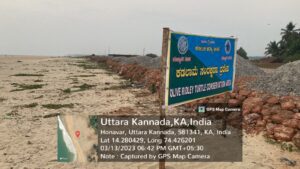
Kutcha road being made by dumping debris in June 2021 on the nesting grounds of Olive Ridley Turtles on the beach
“NH-17 passes through Honnavar towards the east of the project site at a distance of about 1 km. The site is connected to Bellary through NH-63 and NH-17 meets NH-63 near Ankola at about 45 km from the site,” it said.
“Presently, the site can be approached from a single lane black-topped road that runs in continuation to NH-17 and then lies parallel to the shoreline,” it stated, when actually no such road exists.
The EIA report has also outlined the potential impact — or lack of it — under the headline, Socio-Cultural Impact.
“Due to the proposed project, there is no relocation of the local people as the project area is completely on the coastal sand,” it said.
However, the fisherfolk community contested the EIA argument. They said families would have to be relocated to accommodate the illegal 3-km four-lane road.
There are around 1,000 fishermen families — about 6,000 people — living in the village Tonka.
“Among them, there are around 600 houses that are built under the Ashraya scheme. Some of these houses would be razed to construct the road,” Hegde explained.
Environmentalists and activists have been repeatedly questioning the sudden appearance of the kutcha access road when the final EIA report submitted in February 2012 stated there was a blacktopped road.
Karnataka Fisheries and Ports Minister Mankal Vaidya told South First said the government gave the private port nearly 100 acres on lease around 11 years ago.
The Forest Department had given clearance and the surveyors from the district administration went there to conduct a survey.
“Everything is done by keeping in mind the CRZ. There was some disagreement that resulted in a clash, and the law will take its course. It is a 50-metre road and the surveyors had gone there to do their job. There is a temple and a colony,” he further said.
“There are legal suits filed with the NGT in connection to this issue. Without the surveyors doing their job, how will one get to know if there are violations?” Vaidya asked.
He, however, admitted to a major fact. “I agree that there are turtle nesting grounds in the region,” he said.
Environmentalists and activists claimed that the government is trying to illegally redefine the CRZ maps in favour of the private port company to construct an easy access road.
“Legally, the competent authority that can define high-tide lines is the Karnataka State Coastal Zone Management Authority (KSCZMA) and they have already done it in 2019. Why are other government departments attempting to illegally get involved to create new documents in favour of the private port company,” Hegde asked.
“The officials are trying to create a new CRZ map in favour of the private port and it should be questioned,” he asserted.

May 03, 2024

May 03, 2024

May 03, 2024

May 03, 2024

May 03, 2024

May 03, 2024